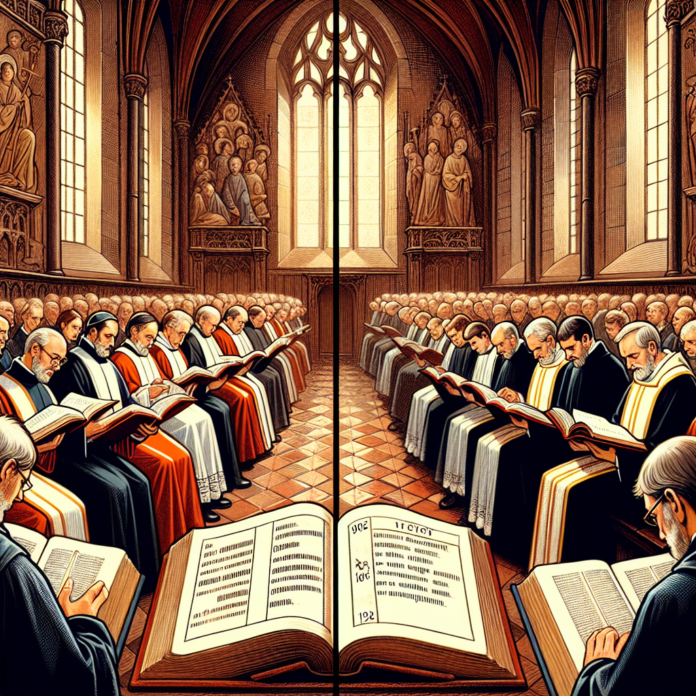The liturgical landscape of the Roman Catholic Church is rife with disputes, none as vivid and entrenched as the discord between followers of the 1962 Missal and the pre-1955 liturgical purists. This division, deeply rooted in historical precedents and influenced by differing interpretations of tradition and modernity, paints a picture of a church continuously grappling with its identity amidst a rapidly-changing world. Although some may romanticize the adherence to old liturgical norms as a marker of devout faith, it is critical to explore the implications of such traditionalism, which by nature, tends to resist necessary progress and inclusivity.
The 1962 Roman Missal, authorized by Pope John XXIII, served as the standard for the Tridentine Mass, a form of the liturgy largely stemming from the Council of Trent in the mid-16th century. This period marked an arduous effort by the Church to recuperate from the Protestant Reformation by establishing uniform liturgical practices. The 1962 Missal aimed to enhance the spiritual experience and reflect a degree of liturgical cohesion, in a time when the Roman Catholic Church was positioned in an ever-diversifying global context.
However, this missal was soon to be overshadowed by the liturgical reforms of the Second Vatican Council (Vatican II), which convened between 1962 and 1965. Vatican II brought forth the Novus Ordo Missae (New Order of Mass) in 1969, which sought to make the liturgy more comprehensible and participatory for the faithful. Latin gave way to the vernacular, and the priest now faced the congregation, symbolizing a more inclusive and community-focused worship experience. Despite these reforms, particular groups clung to the 1962 Missal, believing it to embody the essence of true tradition. They viewed the Novus Ordo with cynical eyes, perceiving it as a departure from orthodoxy and an unwelcome embrace of modernist tendencies.
Amidst this backdrop, another rift emerged—one even more entrenched in historical rigidity. Certain traditionalists took exception not only to the Novus Ordo but also to the pre-1962 reforms initiated by Pope Pius XII in 1955. These purists adhered to the pre-1955 Holy Week rites, which they deemed untainted by what they considered modernist encroachments. The changes introduced by Pius XII were relatively modest: adjustments to the timing and format of certain rites to render them more accessible and resonate more deeply with contemporary Catholics.
The allure of pre-1955 traditionalism lies, partially, in its defiance against any semblance of change. Rituals that predate these modifications had remained relatively unchanged for centuries, and devout purists argue that any alteration compromises the sanctity and solemnity of the rituals. Such reverence for the old ways, however, paints a problematic picture. Traditionalist factions, by clinging to these outdated liturgical forms, inadvertently endorse a form of spiritual elitism. The pre-1955 purists, in particular, isolate themselves not merely from modernity, but from the broader inclusive spirit that is fundamental to the Christian ethos.
Critics might convincingly argue that these doctrinal purists are symptomatic of a greater issue within the Catholic community, where resistance to change often translates to resistance to broader societal progress. By emphasizing rigid ritualistic orthodoxy, these traditionalists stymie the ability of the Church to evolve, potentially alienating younger generations and diverse communities that may seek spiritual inclusiveness, rather than ritualistic insularity.
Moreover, the pre-1955 purists significantly undermine the authoritative structure within the Church. The Church, from its inception, has navigated the confluence of tradition and contemporary relevance. By appealing to an archaic form of liturgy, these purists present an implicit challenge to the Magisterium’s authority and the progressive decrees by subsequent Popes. Their insistence on adhering to ancient rites ostensibly contradicts the Church’s divine guidance to evolve with the needs of its faithful.
The issue extends beyond mere liturgical preference; it speaks to a broader cultural war within the Church, one between progression and regression. The hyperbolic depictions of modernist liturgical reforms as inherently heretical feed into a narrative of fear and mistrust. This cultural conservatism neglects the fact that liturgy is not a static monument but a living tradition designed to inspire and guide a dynamic congregation.
One must be wary of the nostalgia that often informs the views of traditionalist purists. While the ancient rites hold historical and spiritual beauty, their rigid preservation serves as a barricade against the inclusive progress championed by Vatican II. Tradition should not be an anchor holding the Church down but, rather, a lighthouse guiding it through the ever-changing tides of human experience.
In conclusion, the liturgical divide between the 1962 Missal followers and pre-1955 traditionalists reflects a deeper, more nuanced conflict within the Church. Through historical context and critical examination, it becomes evident that extreme traditionalism often veers into reactionary territory, undermining the Church’s mission to be a beacon for all of humanity. By selectively venerating the past at the cost of future inclusivity, these factions endanger the Church’s universal mission, rendering it an anachronistic institution less capable of addressing contemporary spiritual needs.
